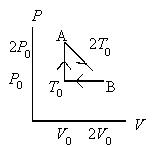Capacitors in Combination: A 5.0-?F, a 14-?F, and a 21 ?F capacitor are connected in parallel. How much capacitance would a single capacitor need to have to replace the three capacitors?
A. 40 ?F
B. 21 ?F
C. 5.0 ?F
D. 14 ?F
Answer: A
You might also like to view...
Measuring the amount of deuterium in the universe allows us to set a limit on
A) the density of ordinary (baryonic) matter in the universe. B) the temperature of the universe at the end of the era of nuclei. C) the total amount of mass in the universe. D) the expansion rate of the universe. E) the current age of the universe.
An ideal gas at pressure, volume, and temperature, P0, V0, and T0, respectively, is heated to point A, allowed to expand to point B also at A’s temperature 2T0, and then returned to the original condition. The internal energy decreases by 3P0V0/2 going from point B to point
T0. In going around this cycle once, which quantity equals zero?

a.
the net change in internal energy of the gas
b.
the net work done by the gas
c.
the net heat added to the gas
d.
All three are zero.
A long straight wire (diameter = 2.0 mm) carries a current of 40 A. What is the magnitude of the magnetic field 1.5 mm from the axis of the wire?
a. 3.0 mT b. 12 mT c. 5.3 mT d. 7.4 mT e. 8.0 mT
What is so special about the carbonaceous chondrites
a. rich in hydrogen and helium b. rich in organic compounds c. rich in nitrogen d. rich in oxygen e. rich in rare metals, such as gold